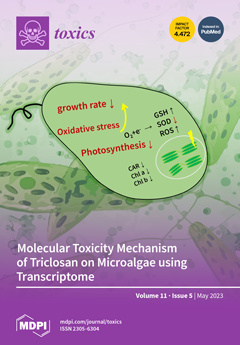Heavy metals as toxic pollutants have important impacts on the photosynthesis of microalgae, thus seriously threatening the normal material circulation and energy flow of the aquatic ecosystem. In order to rapidly and sensitively detect the toxicity of heavy metals to microalgal photosynthesis, in this study, the effects of four typical toxic heavy metals, chromium (Cr(VI)), cadmium (Cd), mercury (Hg), and copper (Cu), on nine photosynthetic fluorescence parameters (φ
Po, Ψ
Eo, φ
Eo, δ
Ro, Ψ
Ro, φ
Ro, F
V/F
O, PI
ABS, and S
m) derived from the chlorophyll fluorescence rise kinetics (OJIP) curve of microalga
Chlorella pyrenoidosa, were investigated based on the chlorophyll fluorescence induction kinetics technique. By analyzing the change trends of each parameter with the concentrations of the four heavy metals, we found that compared with other parameters, φ
Po (maximum photochemical quantum yield of photosystem II), F
V/F
O (photochemical parameter of photosystem II), PI
ABS (photosynthetic performance index), and S
m (normalized area of the OJIP curve) demonstrated the same monotonic change characteristics with an increase in concentration of each heavy metal, indicating that these four parameters could be used as response indexes to quantitatively detect the toxicity of heavy metals. By further comparing the response performances of φ
Po, F
V/F
O, PI
ABS, and S
m to Cr(VI), Cd, Hg, and Cu, the results indicated that whether it was analyzed from the lowest observed effect concentration (LOEC), the influence degree by equal concentration of heavy metal, the 10% effective concentration (EC
10), or the median effective concentration (EC
50), the response sensitivities of PI
ABS to each heavy metal were all significantly superior to those of φ
Ro, F
V/F
O, and S
m. Thus, PI
ABS was the most suitable response index for sensitive detection of heavy metals toxicity. Using PI
ABS as a response index to compare the toxicity of Cr(VI), Cd, Hg, and Cu to
C. pyrenoidosa photosynthesis within 4 h by EC
50 values, the results indicated that Hg was the most toxic, while Cr(VI) toxicity was the lowest. This study provides a sensitive response index for rapidly detecting the toxicity of heavy metals to microalgae based on the chlorophyll fluorescence induction kinetics technique.
Full article






